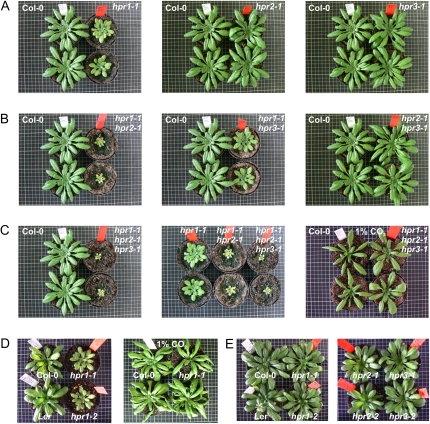Figure 5.
The combined deletion of HPR1, HPR2, and HPR3 leads to a significant decrease in plant growth but is recovered under high-carbon conditions. Plants were grown on soil in ambient air (except for C and D, right panel, which used 1% CO2) with a day/night cycle of 10/14 h (except for E, which used 12/12 h). Photographs were taken after 8 weeks of cultivation. A, Phenotypes of the HPR single mutants (from left to right: hpr1-1, hpr2-1, and hpr3-1) compared with the wild-type control (Col-0). B, Phenotypes of the generated HPR double mutants (from left to right: hpr1-1xhpr2-1, hpr1-1xhpr3-1, and hpr2-1xhpr3-1). C, Phenotype of the isolated HPR triple mutant in normal air (left panel) compared with HPR1 and the HPR1/HPR2 double mutant (middle panel) and under high-carbon conditions (1% CO2) compared with the wild-type control (right panel). D, A stronger phenotype is visible under short days (10/14 h; left panel) but could be compensated by cultivation in elevated CO2 (1%; right panel). E, This effect vanishes by cultivation with longer photoperiods (more than 12 h of light). HPR2 and HPR3 single mutants do not display this effect.

